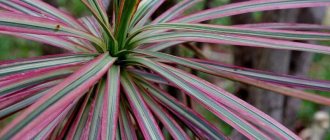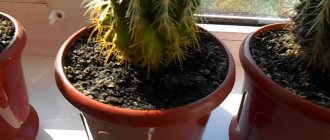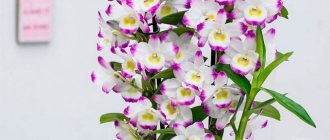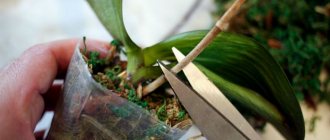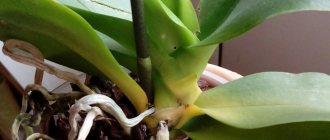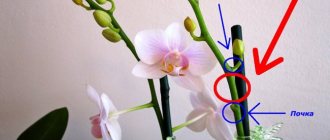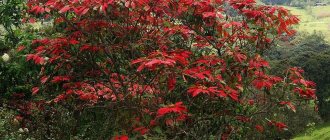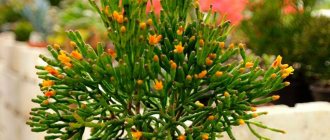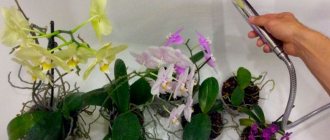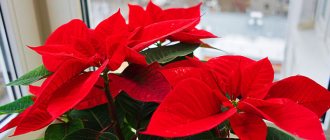Among all the winter flowering plants, poinsettia occupies the main place. The shrub differs from others in the way it flowers. At the top of the bush, bright caps of red or, less often, pink, white, or orange are formed. These are colored stipules, the same in shape as the main leaves, but contrasting in color. The flowers themselves are inside and collected in a small yellow panicle. Another name for the plant is Christmas star. It is precisely the flowering at Christmas and New Year that poinsettia stands out for; how to care for it in winter in order to preserve it longer?
When is the best time to propagate a plant? Is it possible immediately after purchase?
Reproduction is preferably carried out at the very beginning of summer . You should not touch the plant during the dormant period; it lasts almost 2 months, until the end of May.
After transplantation, the plant cannot be fed with anything for a month.
You should purchase a flower with closed buds, since the plant’s adaptation to a new place is long and difficult. The bush cannot be propagated for 1 month.
During the period of adaptation, the plant needs to create temperature conditions of +20 degrees ; it is strictly forbidden to allow drafts in the room.
What soil is suitable for growing?
Nutrient soils “Universal”, “Lemon”, “Ficus” are suitable for growing this flower.
The main thing is that the acidity should not exceed 6 units. When preparing nutrient soil yourself, you need to mix :
- 2 parts leaf soil;
- 3 parts turf substrate;
- 1 part peat;
- 1 part river sand.
As a result, the soil is as loose and light as possible.
How is it propagated by seeds at home?
Under natural growth conditions, the flower reproduces by seed - self-sowing. This is difficult to do at home. Indoor representatives are hybrids, bred by breeders, and the “descendants” do not repeat all the qualities of their “parent”.
Pros and cons of the method
This method has only negative sides.
- It is almost impossible to achieve complete ripening of seeds at home.
- The hybrid plant loses its decorative qualities - flowers and colorful bracts.
- Seed material does not germinate well.
- If the outcome is positive, the plant will begin to bloom only after 3 years.
Seed selection and preparation
To obtain high-quality results, you should purchase seeds from trusted manufacturers . Breeders offer already prepared, processed seed material. Seeds for planting are selected of the same size.
Hollow planting material cannot be used. To check and disinfect, soak for 30 minutes in a weak solution of manganese. All that float are thrown away, and the rest are dried before disembarking.
Step-by-step planting instructions
- A container for growing seedlings is being prepared. You can use special containers, peat glasses or tablets.
- Light nutrient soil is poured. Any universal substrate will do.
- Abundant moistening is carried out with warm, settled water.
- The seeds are carefully laid out on the surface. Sprinkle sifted sand on top.
- The container is covered with film or transparent glass. The glass cannot be removed until the first leaves appear.
- Ventilation is required to protect against rotting and mold.
- After 3-4 true leaves appear, the flower is planted in a larger container.
Remember . A plant grown by seed will not bloom and will look different from an adult hybrid.
Experienced breeders advise propagation by cuttings. Poinsettia juice is poisonous ; when working with the plant, be careful and follow basic safety measures.
Types of plants popular among amateur gardeners
“Natural” poinsettias, despite their abundance, are almost never found among gardeners. Their place is taken by selectively bred hybrids. Most often, plants are classified according to the shade of their bracts:
Red poinsettias are a classic option. A combination of red and bright green (same as the holly wreaths).
Photo gallery: red poinsettias
Angelica - classic red bracts, effectively contrasting with dark green leaves, the shade is bright, but not flashy (other varieties with bracts of the same tone - Sonora, Premium Red, Galactica, Prestige Maroon)
The Olympia variety has pale red bracts that are velvety to the touch, although the leaves themselves are smooth
The Cortez Fire hybrid has bracts that resemble flames, shimmering in shades of red-orange, Peterstar is very similar to it
The “trick” of the Red Diamond (and Freedom) variety is a very pure scarlet color
The hybrid Carousel Dark Red has corrugated bracts along the edges (this is a distinctive feature of the entire group of Carousel varieties)
From a distance, the blooming Winter Rose poinsettia can easily be confused with an old English rose variety - the bracts are round, with slightly turned-back edges
The Champion variety is distinguished by its unusual pale red bracts.
Jester Red poinsettia has bracts the color of fresh blood covered with veins of a darker, burgundy hue.
The Dark Red variety and the similar Freedom Coral have very dark bracts, almost like those of Baccarat roses.
The Harlequin Red variety is distinguished by the shape of its bracts - they are strongly corrugated parallel to the central vein, sharply pointed
Pink poinsettias have colors ranging from soft pastels to crimson and bright neon shades.
Photo gallery: pink plant varieties
Variety Maren, Pink Ribbon and some others - classic pink color
Poinsettia Freedom Pink - a very delicate, creamy pink shade
Hybrid Cortez Pink - unusual peach or salmon tone, depending on growing conditions
Variety Pink Ell very bright crimson bracts
Monet Twilight and similar Da Vinci - light and dark shades smoothly flow into each other, pinkish bracts seem to be sprinkled with flour
The Annette Hegg poinsetti has dark crimson bracts.
White poinsettias are not very popular compared to others, but no less impressive. They are even more elegant and graceful.
Photo gallery: white poinsettias
The Regina variety is characterized by the presence of clearly visible lettuce veins on a white background
Silverstar White - pure snow-white color of the bracts
Whitestar - white has a slight green tint
In the Freedom White hybrid (as well as Polar Bear, Infinity White), the bracts are silvery in artificial light
Cortez White and similar Sonora White - an unusual shade of ivory, slightly shimmering with mother-of-pearl
How to propagate cuttings at home?
Division by cuttings is carried out in August or September. Propagation material is taken from an adult plant. Only well-formed and healthy shoots are used.
Pros and cons of the method
| pros | Minuses |
| A common and simple method of reproduction | Poor lighting will stop the development of the plant |
| A few healthy cuttings are enough for propagation. | If the sap is not removed, the root system will not form. |
| Following simple rules will allow you to bloom every year. | Poinsettia juice is poisonous |
| You can propagate by cuttings not only in soil, but also in water | It is necessary to control soil moisture |
| Several plants can be placed in one rooting container, thanks to this procedure the foliage will become lush and voluminous | Drafts are not allowed in a room with a growing flower. |
Selection and preparation of cuttings
It is necessary to take adult stems from a three-year-old poinsettia. The strongest and healthiest are selected. Cut into equal parts, around 4-6 internodes.
Step-by-step instructions for rooting
- The apical stem is cut into cuttings 10 cm long, each leaving at least 4 leaves.
- The cut is made under the node, the lower leaves are removed.
- To stop the secretion of juice, the cuttings are dipped in warm water for 15 minutes.
- For 4 hours, cut branches are dipped in a stimulating solution, for example “Kornevin” or “Living Force”.
- The container for planting is filled with a special substrate consisting of sand, manure and humus in a ratio of 1/1/2. You can use any nutrient soil.
- The cuttings are carefully buried to the first node, about 2 cm.
- For germination, the room temperature is maintained at +24-+ 28 degrees.
- The container is covered with a transparent film to preserve the “greenhouse” effect.
- To speed up the process, additional lighting is used using a phytolamp.
The phytolamp is located at a distance of at least 30 cm from the plant. - The seedlings are regularly ventilated, at least once a day.
- Spraying is carried out as the soil dries with exclusively warm water.
- The film is removed after 2 weeks.
- After planting, the seedling is fed with any humic fertilizer: “Humite” or “Living Force”.
- The rooting process lasts a month. After the first young leaves appear, the cuttings are pinched to begin the early formation of a beautiful bush.
- The most comfortable temperature for poinsettia growth is from +18 to +24 degrees.
- Transplantation of cuttings into large containers is carried out in the fall. Before this, a thick layer of drainage is placed on the bottom of the pot.
- The plant will be fully formed after 12 months.
Attention! To make the plant endure the process more easily, replanting is carried out with an earthen clod, the “transshipment method”.
How to grow a flower in open ground?
In the summer, it is better to transplant poinsettia into the garden . In winter, the plant must be returned indoors; it will not grow outdoors.
For the comfortable existence of the bush, some mandatory rules of care are observed:
- For transplanting into open ground, select the most sunny area in the garden.
- The planting site is pre-fertilized with any mineral preparation intended for flowers.
- The poinsettia is transferred to the prepared place very carefully using the “transshipment method”.
- Fertilizer is applied to pre-moistened soil - this will protect the root system from possible damage. Fertilizer is applied directly to the ground every 14 days.
- This plant instantly reacts to changes in humidity. It does not tolerate overwatering, but drought is also detrimental to poinsettias.
- After transplantation, the flower must be covered with a transparent vessel.
Diseases and pests of poinsettia
The problems that a gardener faces when transplanting, propagating and pruning poinsettias at home are associated with violations of the rules of care. Although this plant cannot be called capricious, the flower can be attacked by insects, pathogenic fungi and dangerous bacteria.
Among the diseases and pests of poinsettia, the greatest harm is caused by all kinds of rot, caused by non-compliance with the watering regime and keeping the flower in an excessively hot or excessively cold room. Infection with fungal infections and soil pests, such as nematodes or mealybugs, cannot be ruled out if the flower is transplanted into a substrate that has already been used and has not been disinfected. A plant located in dry air is readily attacked by spider mites.
However, insects do not always lie in wait for poinsettias at home. Often, already from the manufacturer, a flower ends up on the windowsill infected with whiteflies hiding on the back of the leaves.
The fight against diseases and pests of poinsettia consists of normalizing living conditions and treating the source of the problem with fungicides or insecticides. Parts of the plant affected by the fungus should be removed, and the damaged soil must be replaced.
How to care immediately after planting?
The main thing is to carefully monitor the humidity level. The soil should not become crusty; overflowing is unacceptable . During the growing season, fertilizer is applied with mineral complexes at least 2 times a month.
Important! The plant drops all its leaves after flowering.
Poinsettia is considered a Christmas flower, and many gardeners try to time the plant's flowering to coincide with the winter holidays. For this purpose, at the end of September, a “night effect” is artificially created for it. Over the course of 2 weeks, the bush is covered with thick fabric for almost the whole day. Thanks to the shortening of the sunny day, the flowering process will occur just in time for the required period.
What to do if it doesn't bloom?
The Christmas star is a capricious pet, which for the gardener means the need to exclude any unfavorable influences for it, since they can delay flowering indefinitely. Therefore, it is recommended to stimulate it. From the beginning of October, poinsettias undergo a darkening period of 8 weeks. To do this, cover the Christmas star with a blanket, box, or opaque cap for 14 - 15 hours a day. Temperature range is 15 - 16 degrees at night and 20 - 21 degrees during the day. It is very important that the closed plant is not exposed to sunlight or artificial light, even for a short time. By the beginning of December, buds should already form on the shoots and the darkening should be removed. The plant is placed in a bright place and cared for as an adult and healthy one during flowering. Despite the fact that poinsettia is quite difficult to grow due to its high susceptibility to the influence of unfavorable factors and because of its demanding conditions for its maintenance, a gardener who strictly follows all recommendations for maintenance and care regimes will be able to observe its decorative flowering all winter and will understand, why is this milkweed called the most beautiful?
